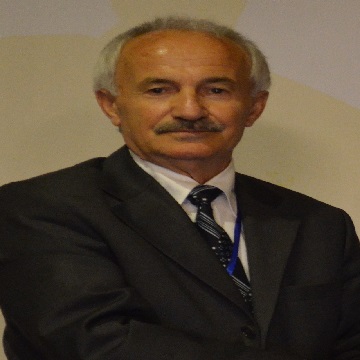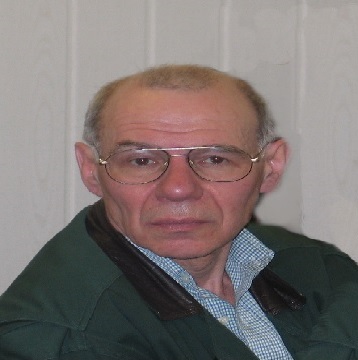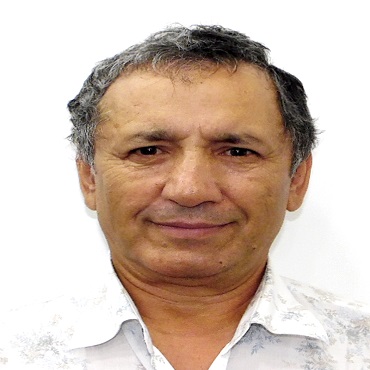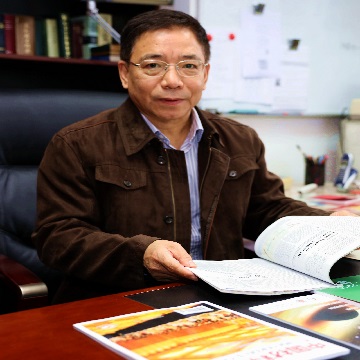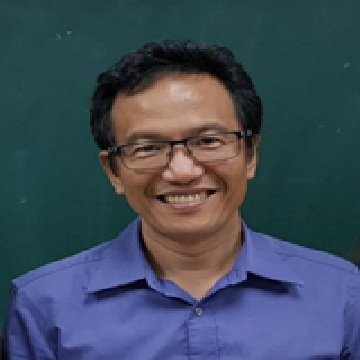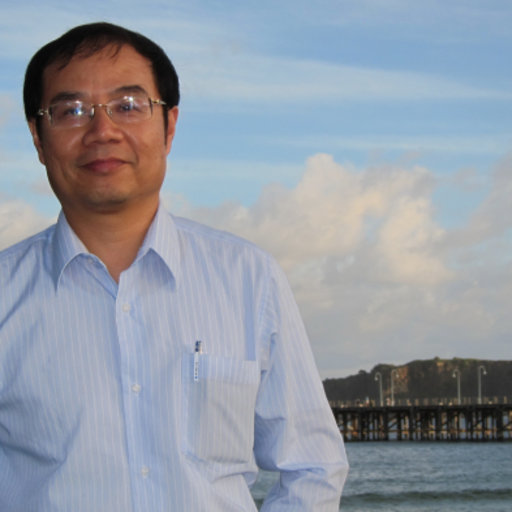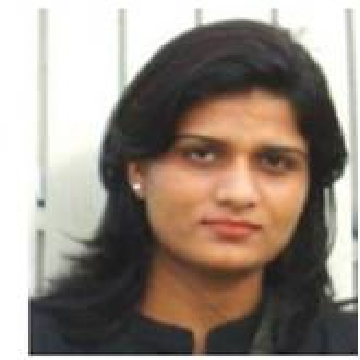Scientific Program
Keynote Session:
Title: Nanoscale aspects of phase transformations in shape memory alloys
Biography:
Osman Adiguzel graduated from Department of Physics, Ankara University, Turkey in 1974 and received PhD- degree from Dicle University, Diyarbakir-Turkey. He has studied at Surrey University, Guildford, UK, as a post doctoral research scientist in 1986-1987, and studied on shape memory alloys. He worked as research assistant, 1975-80, at Dicle University and shifted to Firat University, Elazig, Turkey in 1980. He became professor in 1996, and he has already been working as professor. He published over 60 papers in international and national journals; He joined over 100 conferences and symposia in international and national level as participant, invited speaker or keynote speaker with contributions of oral or poster. He served the program chair or conference chair/co-chair in some of these activities. In particular, he joined in last six years (2014 - 2019) over 60 conferences as Keynote Speaker and Conference Co-Chair organized by different companies. He supervised 5 PhD- theses and 3 M.Sc- theses. Dr. Adiguzel served his directorate of Graduate School of Natural and Applied Sciences, Firat University, in 1999-2004. He received a certificate awarded to him and his experimental group in recognition of significant contribution of 2 patterns to the Powder Diffraction File – Release 2000. The ICDD (International Centre for Diffraction Data) also appreciates cooperation of his group and interest in Powder Diffraction File.
Abstract:
Shape memory effect is a peculiar property exhibited a series alloy systems in the β-phase fields. Shape memory alloys are sensitive to external condition and temperature, and crystal structure of these alloys change with changing temperature and stressing, by means of structural phase transformation, called martensitic transformations. Shape memory effect is treated thermally by means of thermal induced martensitic transformation, which occurs as martensite variants with lattice twinning in crystallographic or atomic scale, sub-nano scale, in materials on cooling below martensite finish temperature. Twinned martensite structures turn into detwinned martensite structure by means of stress induced martensitic transformation by stressing material in a strain limit in martensitic condition. Shape memory alloys are in the fully martensitic state below martensite finish temperature with fully twinned structure can be easily deformed through variant reorientation/detwinning process. Therefore, martensite is called soft phase and austenite is also called hard phase. Thermal induced martensitic transformation is lattice-distorting phase transformation and occurs as martensite variants with the cooperative movement of atoms by means of shear-like mechanism. Martensitic transformations occur by two or more lattice invariant shears on {110}-type planes of austenite matrix which is basal plane or stacking plane for martensite. In the martensitic transformation, the lattice of high temperature austenite phase has greater crystallographic symmetry than that of the low-temperature product phase. Copper based alloys exhibit this property in metastable β-phase region, which has bcc-based structures at high temperature parent phase field. Lattice invariant shears are not uniform in copper based shape memory alloys, and the ordered parent phase structures martensitically undergo the non-conventional complex layered structures on cooling. The long-period layered structures can be described by different unit cells as 3R, 9R or 18R depending on the stacking sequences on the close-packed planes of the ordered lattice. The unit cell and periodicity is completed through 18 layers in direction z, in case of 18R martensite, and unit cells are not periodic in short range in direction z. In the present contribution, x-ray diffraction and transmission electron microscope studies were carried out on two copper based CuZnAl and CuAlMn alloys. These alloy samples have been heat treated for homogenization in the β-phase fields. X-ray diffraction profiles and electron diffraction patterns reveal that both alloys exhibit super lattice reflections inherited from parent phase due to the displacive character of martensitic transformation. X-ray diffractograms taken in a long time interval show that diffraction angles and intensities of diffraction peaks change with the aging time at room temperature. In particular, some of the successive peak pairs providing a special relation between Miller indices come close each other, and this result leads to the rearrangement of atoms in diffusive manner.
Title: Interaction of corrosion-induced hydrogen with nascent nanodefects in steel under neutron irradiation
Biography:
Evgenii Krasikov has doone his education from Moscow Power Engineering Institute. Degree(s) or Diploma(s) obtained: Master’s Degree in Material Science – 1970, Ph.D. – 1974, D.Sc. -2005. Membership of professional bodies: member of Scientific Council of RAS on Radiation Damage Physics of Solids. Years within the firm: since 1974. Key qualification: responsible executor in Radiation Damage Physics of Solids. Professional experience record: since 1974 till now, Moscow, National Research Centre "Kurchatov Institute”, Department: Reactor Materials and Technologies Institute.
Abstract:
As the service life of an operating nuclear power plant (NPP) increases, the potential misunderstanding of the degradation of aging components must receive more attention. Integrity assurance analysis contributes to the effective maintenance of adequate plant safety margins. In essence, the reactor pressure vessel (RPV) is the key structural component of the NPP that determines the lifetime of nuclear power plants. Environmentally induced cracking in the stainless steel corrosion-preventing cladding of RPV’s has been recognized to be one of the technical problems in the maintenance of light-water reactors. Therefore, in the case of cladding failure, the problem arises of hydrogen (as a corrosion product) embrittlement of irradiated RPV steel because of exposure to the coolant.
The effects of neutron fluence and irradiation temperature on steel/hydrogen interactions (adsorption, desorption, diffusion, mechanical properties at different loading velocities, post-irradiation annealing) were studied. Experiments clearly reveal that the higher the neutron fluence and the lower the irradiation temperature, the more hydrogen-radiation defects occur, with corresponding effects on the RPV steel mechanical properties. Hydrogen accumulation analyses and thermal desorption investigations were performed to prove the evidence of hydrogen trapping at irradiation defects. Extremely high susceptibility to hydrogen embrittlement was observed with specimens which had been irradiated at relatively low temperature. However, the susceptibility decreases with increasing irradiation temperature. To evaluate methods for the RPV’s residual lifetime evaluation and prediction, more work should be done on the irradiated metal–hydrogen interaction in order to monitor more reliably the status of RPV materials.
Oral Session 1:
- Advanced Materials and Functional Devices | Engineering Materials & Composite Materials | Magnetic and Multiferroic Materials
Title: Water blown natural bubber foam: a greener and sustainable approach using microwave foaming technique
Biography:
Lukmon Owolabi Afolabi is currently a faculty member of FKMP / UTHM and previously a postdoctoral research fellow at Universiti Sains Malaysia (USM) and University Technology Petronas (UTP) Malaysia. He obtained his PhD degree from UTP, Malaysia. His research is in areas of sustainable development, renewable energy studies, polymer composites and nanotechnologies. He’s currently working to develop an innovative process techniques on electrospine of coated hollow microspheres crystal structure for lightweight syntactic foams fabrication for engineering applications. He has published papers many reputed journals, conferences and book chapters. His is a guest editor, assistant editor and reviewer of repute. Dr. Lukmon also pursues interests infusing new technology into the energy storage materials for advance thermal transport. He is a chartered engineer and member of Institute of mechanical engineers (MIMechE) UK.
Abstract:
This study mainly concerns the role of foam heating process techniques and its impact on cellular micromorphology, density and gas liberation mechanism of natural rubber foam with distilled water as blowing agent. Three different modes of heating process techniques and varying amount of distilled water have been examined on the foam density and cellular morphology, having rather identical morphological formation, cell distribution and relatively reducing densities but significant cell wall thickness. It is deduced that the increase in the water loading substantially affects the decrease in the foam densities, cell uniformity and stability. However, the heating process techniques influence the cell distribution and stability more than the amount of water content loading. The combine microwave oven process technique has improved the process of moisture diffusion into the water-blown open cell natural rubber foam unlike the slower procedure of conventional heating technique. In addition, the natural rubber foam physical properties and microstructure is improved better than the conventional heating technique. In all the simultaneous combine microwave oven technique is the best among the evaluated technique for the experiment because of density increment, cell distribution, pores flaccidity and uniform cells.
Title: A powerful explosion of light for production of porous materials and nanotechnology
Biography:
Kholmurad Khasanov has been working as a prime investigator in the physics area for almost 40 years, and achieved one of his most iconic discoveries in 2011, when He designed and started experimenting with his dynamic emitter. He has published about 100 papers in reputed journals. He has collaborated with several international organizations including NASA and "The Smithsonian"; my works can be found in the "Astrophysics Data System" under the Fluid Dynamics section. My experiments show great results in the production of nano-structures, and the applications
Abstract:
American scientist D. Fisher paid attention to the "point of infinite compression, a special “singular” point. Mathematically, it corresponds to a function having an explosive derivative. Professor of the University of Munich R. Kippenhan in his work noted that "from the surface of the star quantum electromagnetic radiation rushes into interstellar space." reaching our atmosphere creates converging spherical waves leading to an infinite point of compression, having an explosive character. Our studies have shown that these electromagnetic waves are to a large extent the ultraviolet radiation of the near range of 400-300nm. The near ultraviolet range is often called “black light,” since the human eyes do not recognize it. Black light when colliding with the atmosphere continuum forms converging spherical supercompression waves. These waves when they reach the atmosphere of the earth create an explosive field. Our dynamic emitter of the original design generates spherical converging shock waves in a supersonic jet, leading to the point of infinite compression "special point" having an explosive derivative. The jet, interacting with the atmospheric background ultraviolet radiation, entering into the resonance mode generates a powerful explosion of black light , the energy of which provides the synthesis of porous nanomaterial. The principle of operation of the emitter in practice has shown that the energy of a powerful explosion of black light in the laboratory and in production is a safe, cost-effective source of energy.
Title: Studies on carbon fiber reinforced silicon nitride composites prepared using spark plasma sintering
Biography:
M. Balasubramanian obtained his Ph.D. degree from the Indian Institute of Technology, Madras in the year 1996 for his work on, “Processing and Characterisation of Alumina-Zirconia Powders and Compositesâ€. Currently, he is a Professor in the metallurgical and materials engineering department of the Indian Institute Technology Madras. He is actively involved in teaching and research of ceramics and composites. He has published more than 75 research papers in refereed international journals. He has published a book with CRC Press on, Composite materials and processing.
Â
Abstract:
Silicon nitride (Si3N4) powder is synthesized using nitridation of silicon powder at 1400°C with N2-H2 gas mixture. The laboratory synthesized silicon nitride powder is mixed with various quantities of carbon fibers (5 to 20 vol. %) and sintering additives (6 wt. % Y2O3 + 2 wt. % Al2O3+ 1 wt. %MgO) through ball milling for 2 h. These mixtures are spark plasma sintered at three different temperatures (1400, 1500 and 1600 °C) at 40 MPa pressure for 10 min. The phase analysis after sintering shows that the composite samples have β-Si3N4 phase without any residual a-phase, irrespective of the sintering temperature. The carbon fiber reacted with the Si3N4 matrix and resulted in the formation of SiC through the interface reaction. The Rietveld quantification results show that the amount of SiC formation in the composite is less when the fiber content is high. Strong interfacial bonding is observed up to 10 vol. % Cf addition and the interfacial bonding is weak for 15 and 20 vol. % Cf composites. This is reflected in the fracture toughness values, where the highest value (7.1 MPa m1/2) is observed for 20 vol. % Cf-Si3N4 sintered at 1600 °C. However, the flexural strength values are less for the composites with high Cf content compared to that of composites with low Cf content.
Title: Multifunctional biocatalytic submarine-like micromotors for directional vertical motion
Biography:
Ziyi Guo is a PhD candidate at the school of Chemical Engineering and Graduate School of Biomedical Engineering in University of New South Wales (Australia), supported by the Australian Government Research Training Program Scholarship. She obtained her BSc degree in Materials Science and Engineering in Central South University (China) in 2017. Her research interests focused on smart responsive nano-bio-hybrid materials
Abstract:
Artificial and micro/nano biohybrids have emerged as an exciting branch of research at the interface of materials engineering and biological science. People have found vast potential for applications ranging from nanomedicine to environmental remediation.1 Among the biohybrids, self-propelled artificial micromotors have been extensively investigated in the last few years, showing promise for controlled drug delivery, sensors, environmental remediation, and micromanipulation. However, strategies for developing methods to achieve precise and corporative autonomous directional movement of these nanomachines in an isotropic solution (e.g. without chemical, physical gradient or any form of external manipulation) is not yet achieved. As we advance toward real-world applications, steering of the motors to a specific destination and with speed regulation will be required.
Here, we report for the first time the design of a novel submarine-like micromotor that is capable of regulating its buoyancy force to achieve reversible, corporative directional vertical motion in centimeter-scale2. Guided by density functional theory (DFT) calculations, we synthesized a composite metal-organic framework (MOF)-based micromotor system containing a bioactive enzyme as the engine for gas bubble generation and a pH-responsive, hydrophilic/hydrophobic phase-shifting polymer as the gear to tune the micromotor buoyancy force through modulated interaction with the produced gas bubbles. We show that the gas bubbles produced by the micromotor can be reversibly retained/expelled from the micromotors, leading to the buoyancy-controlled ascending or descending vertical motion. Importantly, anti-cancer drug-loaded micromotors showed directional cytotoxicity to the three-dimensional cell cultures, depending on the pH of the cellular environment. We found that such facile and versatile method for exploring novel driving forces for motion manipulation could be further applied to colloidal science and electrochemistry, showing potential as smart cargo transport microsystems that could accomplish more challenging tasks by exploiting the complex biological environment
Title: Biocompatible polymer-exfoliated nanosheets with ultra-high drug loading as safe and efficacious cancer therapeutics
Biography:
He Zhang is a second year PhD candidate in the major of Chemical engineering at University of New South wales. His research maily focous on desgining 2D nanomaterilas towards efficient drug delivery system
Abstract:
Two-dimensional (2D) layered double hydroxide (LDH) nanoparticles have been widely studied for biomedical applications due to its tremendously biocompatible properties at the nanoscale. Exfoliating LDH nanoparticles into ultrathin nanosheets is an efficient way to maximize the utility of each single layer, which possess the higher specific surface area. However, current exfoliation methods of LDH nanoparticles are either time-consuming or lack of biocompatibility (bottom-up method), which remains a bottleneck for biomedical applications of LDH nanosheets. Herein, we developed a novel and rapid method to synthesis ultrathin LDH nanosheet with a thickness of around 3nm via bottom up method. In this work, the modified Poly (ethylene glycol) (PEG) is not only successfully applied as layer inhibitor to urge the formation of LDH nanosheet, but also acted as a surfactant to improve its biocompability, making this ultrathin LDH nanosheet an excellent candidature for drug delivery system. Comparted with pristine LDH nanoparticles, this nanosheets show a good colloid stability among different artificial biological solutions. It is also featured with superb drug loading capacity and loading efficiency of universal anticancer drug doxorubicin (DOX). This nanosheet loaded DOX also exhibit a pH-controlled DOX releasing manner, indicating a good tumour selectivity. Additionally, both in vivo and in vitro results reveal the excellent anticancer activity and superior biocompatibility of the DOX loaded nanosheet. overall, this work provides a potential strategy of modifying functional LDH nanosheet for its bioapplication in drug delivery system.
Title: Development of porous-organic-polymer driven cobalt phosphide hybrid nanosheet: A smart and durable material for bio-fuel upgradation via hydro-deoxygenation pathway
Biography:
I have done Master of Science (MSc) in Chemistry from Indian Institute of Technology, Kharagpur, (IIT-KGP) the one of the prestigious and premiere academic organization in India. Currently, I am pursuing PhD from CSIR-Indian Institute of Chemical Technology (CSIR-IICT) under the supervision of Dr. John Mondal, Scientst at Catalysis & Fine Chemicals (C&FC) division. I have been working on “Development of Robust Porous Nanoarchitecture as Heterogeneous Catalyst for Energy and Environmental application.” I have already published in 7 publications (89 citations with h-index 6) in International Journals of well repute.
Abstract:
Hydrodeoxygenation (HDO) is a promising route for the upgrading of bio-oils to eco-friendly biofuel produced from lignocellulose.1 Herein, we report the sequential synthesis of a hybrid nanocatalyst CoxP@POP, where substoichiometric CoxP nanoparticles are distributed in a porous organic polymer (POP) via solid-state phosphidation of the Co3O4@POP nanohybrid system. We also explored the catalytic activity of the above two nanohybrids toward the HDO of vanillin, a typical compound of lignin-derived bio-oil to 2-methoxy-4-methylphenol, which is a promising future biofuel. The CoxP@POP exhibited superior catalytic activity and selectivity toward desired product with improved stability compared to the Co3O4@POP. Based on advanced sample characterization results, the extraordinary selectivity of CoxP@POP is attributed to the strong interaction of the cation of the CoxP nanoparticle with the POP matrix and the consequent modifications of the electronic states. Through attenuated total reflectance-infrared spectroscopy, we have also observed different interaction strengths between vanillin and the two catalysts. The decreased catalytic activity of Co3O4@POP compared to CoxP@POP catalyst could be attributed to the stronger adsorption of vanillin over the Co3O4@POP catalyst. Also from kinetic investigation, it is clearly demonstrated that the Co3O4@POP has higher activation energy barrier than the CoxP@POP, which also reflects to the reduction of the overall efficiency of the Co3O4@POP catalyst. To the best of our knowledge, this is the first approach in POP-encapsulated cobalt phosphide catalyst synthesis and comprehensive study in establishing the structure-activity relationship in significant step-forwarding in promoting biomass refining.
Title: Carbon nanotube assemblies for lead detection in drinking water
Biography:
Dr Alvarez is an assistant professor at the U of Cincinnati , Chemistry Department. He got his PhD from Rice University in 2010 (USA), MSc from McNeese State University (USA), and Bachelor from Universidad de San Simon (Bolivia). His research is focused to carbon nanomaterials and applications. He has published 50 papers, owns 7 patents and has given multiple talks across USA. More information about his research could found at: https://www.alvarezlab.com
Abstract:
Lead exposure concerns have spread among multiple developed countries, high concentrations of Lead in drinking water have been reported in the North America, Europe and Asia. In America, detection of heavy metals in water has become a high priority for societies, particularly those living in cities where water infrastructure was developed built prior 1986. Rapid detection or continuous monitoring of lead, in drinking water is needed to ensure safe drinking water supplies for our communities. This talk will highlight the current progress toward the development of an electrochemical sensor based on carbon nanotubes from synthesis to applications in Lead and other heavy metal detection. The unique physical properties of individual Carbon Nanotubes (CNTs) surpass the properties of many advanced materials available today. Due to their large surface area, chemical stability, and electrical conductivity, they are the most promising candidates for a large number of electroanalytical applications. A material for sensor applications requires high purity CNT assemblies like fibers and films, that have good electrical conductivity, in some case additional insulation coatings. Polymer coated CNT fiber was used as the working electrode; bare CNT thread was used as the auxiliary electrode; and a pseudo-reference electrode was fabricated by electroplating CNT fiber with Ag that is subsequently anodized in chloride solution to form a layer of AgCl. This all-carbon CNT fiber three electrode cell is evaluated for simultaneous detection of trace levels of heavy metal ions by anodic stripping voltammetry (ASV). Hg , Cu and Pb in H2O were detected successfully, and the detection limits are 1.05 nM, 0.53 nM and 0.57 nM for Hg , Cu and Pb , respectively. These electrodes significantly reduce the dimensions of the conventional three electrode electrochemical cell and have the potential to become low cost and on-site lead sensor.
Keynote Session:
Title: Solar fuel production: opportunities for nanostructures
Biography:
Zhigang Zou received his Ph.D. degree in 1996 from the University of Tokyo. He is the Cheung Kong Scholars professor in the department of physics, and the director of Ecomaterials and Renewable Energy Research Center (ERERC) in Nanjing University, China. His research interests include superconductor, photocatalysis, and photoelectrochemisty for solar fuel production. He has published over 600 papers, cited for more than 20000 times with the H-index of 72, and achieved more than 90 China's invention patents, 1 U. S. patent, 2 Japanese patents. In 2015, he was elected the member of Chinese Academy of Sciences, and in 2018, he was elected the member of the World Academy of Sciences.
Abstract:
The photocatalytic and photoelectrochemical reduction of water or CO2 is an intriguing approach to producing sustainable solar fuels, and has attracted growing and intense interest. Nanostructuring of photocatalysts and photoelectrodes has been proven to be a strong strategy to dramatically improve overall solar-to-fuel conversion efficiencies. Another technological barrier for the practical implementation of solar fuel production is long-term material durability, which has recently been well addressed by using conformal coatings of protective layers onto the narrow band-gap semiconductors that are suitable for efficient solar-to-fuel conversions but photoelectrochemically unstable. These significant progresses may lead us to the practical implementation of solar fuel production. We focused on the exciting progresses achieved by using nanostructuring strategies, specifically regarding how the nanostructure influences the charge transport and separation. Special attention was paid to investigate how a nanoscale coating (overlayer) passivates the surface states, thereby reducing the surface electron hole recombination, and how a nanoscale coating (protective layer) prevents the photocorrosion or photopassivation of the semiconductors with optimal band gaps. We hope that the design strategies using these nanostructures will offer new and greater opportunities for efficient solar fuel production to existing photocatalytic and photoelectrochemical systems.
Â
Oral Session 1:
- Advanced Optical & Magnetic Materials | Advancement in Nanomaterials Science & Nanotechnology | Nano Materials & Their Properties | Nano Medicine & Drug Delivery
Title: An automatic demulsification sponge for separation of oil/water emulsion
Biography:
Dr. Ping-Szu Tsai currently is a Professor of the Department of Chemical and Materials Engineering. He received his B.S. degree in chemical engineering from National Taiwan University of Science and Technology, Master degree in college of Pharmacy from Kaoshiung Medical University and Ph.D. degree in chemical engineering from National Cheng Kung University. Dr. Tsai joined National kaoshiung University of Science and Technology in 1992. Dr. Tsai’s current research interests include oil/water separation technology, organic/inorganic nanohybrids, regeneration bitumen, emulsified bitumen/diesel, ,transparent/superhydrophobic coating and synthesize of functional polymers.
Abstract:
The oil droplets contained in wastewater often caused considerable troubles in wastewater treatment. Especially for the oil-water emulsions containing oil droplets with small particle size. The engineers and the researchers are always pursuing advanced materials and technology to deal with them.
Recently, a polymer with a quaternary amine structure was synthesized in our laboratory. We have applied such polymer to sterilization and separation of oil-water emulsions and achieved good results.
When such a monomer is specifically polymerized in sponges having particular pore structure, the emulsion-containing wastewater was separated perfectly(efficiency > 99%). Besides, these sponges exhibited a surprising automatic demulsification effect in just a few minutes. The application of the basic principles of electrostatic adsorption, concentration diffusion, aggregation, and density convection are used to explain the mechanism of the automatic demulsification effect. We believed that the discovery of this phenomenon will help the academic and engineering communities to develop more efficient automatic demulsification sponges in the near future.
Title: Synthesis of a luminescent molecular imprinting polymer nanocomposite via encapsulation approach for biorecognition
Biography:
Dr. Tzong-Liu Wang currently is a Professor of the Department of Chemical and Materials Engineering and had served as Dean of the College of Engineering at National University of Kaohsiung. He received his B.S. degree in chemical engineering from National Tsing-Hua University and Ph.D. degree in materials science & engineering from University of Utah. Dr. Wang joined National University of Kaohsiung in 2004. Dr. Wang’s current research interests include polymer solar cells, organic/inorganic nanohybrids, organic & inorganic optoelectronic materials, functional polyurethanes, and synthesis and characterization of functional polymers.
Abstract:
In recent years, moleoularly imprinted polymers (MIPs) have attracted considerable interests for their applications in biotechnology. MIPs possess selective and specific cavities for recognition and binding of the target molecules with high affinity and specificity. The interactions between the polymer and the target molecules consist of electrostatic interactions, hydrogen bonds, Van der Waals forces, and hydrophobic interactions.
In this study, a luminescent molecular imprinting polymer nanocomposite was prepared via the encapsulation approach. The LiYF4:Yb3+0.25/Er3+0.01/Tm3+0.01/Ho3+0.01@LiYF4:Yb3+0.2 and LiYF4:Yb3+0.25/Tm3+0.01@LiYF4:Yb3+0.2 core/shell upconversion nanoparticles (UCNPs) were prepared as the luminescent nanoparticles by thermal decomposition method. The [Poly(methacrylic acid)-co-octadecene] (P(MAA-co-OD)) copolymer was synthesized as the moleoularly-imprinted polymer and imprinted with the templates of glycine, bovine serum albumin and bovine hemoglobin. The prepared UCNP@P(MAA-co-OD) MIP nanocomposite (MIP-NC) could emit green and red and UV/Vis light respectively. Both luminescent bands could be absorbed by the template molecules and the biomolecules to be recognized.
The particle size of MIP-NC determined by dynamic light scattering (DLS) showed that the size was in the range of 1.30 mm to 1.95 mm. Thermogravimetric analysis (TGA) indicated that the weight ratio of UCNPs in the MIP-NC was ca. 2%. The recognition and re-adsorption effect of the luminescent MIP-NC for the three template molecules after molecular imprinting were determined by the absorption intensity of the ultraviolet-visible (UV/Vis) spectra and photoluminescence (PL) measurements.
The prepared MIP-NC was used as a biosensor for recognition of human red blood cells and ractopamine. The UV/Vis analysis showed that the adsorption of human red blood cells by the synthesized MIP-NC was better than that of ractopamine. Photoluminescence spectra and the result of Stern-Volmer equation indicated that the light quenching effect of human red blood cell was higher than that of ractopamine. Therefore, the MIP-NC prepared in this study has a better recognition effect on human red blood cells.
Title: Carboxymethyl cellulose film-implant with silver nanoparticles for the treatment of burns with different etiology
Biography:
Khaydar Yunusov is a Associate Professor at Institute of Polymer Chemistry and Physics, Academy of Sciences of the Republic of Uzbekistan, Uzbeskistan.
Abstract:
Silver nanoparticles inhibit the activity of the enzyme providing oxygen exchange in protozoa, such as pathogenic bacteria, viruses, and fungi (about 700 species of pathogenic flora and fauna) [1]. The transition from the ionic Ag+ form to metallic nanoclusters makes it possible to reduce silver’s toxicity to cells of higher organisms without suppression of the antimicrobial activity against pathogenic microflora. Silver nanoparticles, especially stabilized ones, have greater stability and prolonged action [2]. Sodium carboxymethylcellulose (Na-CMC) - a water - soluble film forming biodegradable polymer widely used in the production of oral pharmaceuticals and drugs for external use primarily to increase the viscosities of ointments, in the production of pastes as hydrogel bases, and in the production of drugs for parenteral use - is of high interest as a stabilizer of silver nanoparticles. In addition, Na-CMC is utilized as a binding and disintegrating agent in the production of tablets. Na-CMC is one of the key components of adhesive absorbing systems employed to treat problematic wounds, to remove extravasates, sweat, and the contents of wounds, and to regulate the kinetics of release of active substances of systems contacting mucous membranes.
The aim of this study is to prepare stabilized silver nanoparticles in polymer films based on Na-CMC and to investigate their structures, physical and chemical properties, and microbicidal activities.
Industrial samples of Na-CMC with degrees of substitution of 0.65-0.85 and degrees of polymerization of 200-600 obtained from cotton cellulose were used as polymer matrices after their purification from inorganic and organic admixtures. To prepare silver nanoparticles in the films based on CMC, AgNO3 aqueous solutions of various concentrations were utilized. The bacterium Staphylococcus epidermidis and the yeast fungus Candida albicans - pathogens of humans and animals-were used as test cultures.
To form the films, 2-4% aqueous solutions of purified Na-CMC samples with various degrees of substitution and polymerization were employed after the removal of the gel fraction via centrifugation with a laboratory centrifuge at 2500 rpm for 20 min. Then, calculated amounts of 0.1-0.001 M aqueous solutions of AgNO3 and 0.1-0.5% glycerol, which played the role of a plasticizer, were added under stirring to the gel free Na-CMC solutions, and the stirring was continued until homogeneous Ag+CMC– hydrogels formed.
The photochemical reduction of silver ions in the Ag+CMC– structure to nanoparticles was performed at 25°Ð¡ through their irradiation with a DB-250 high pressure mercury lamp. The dispersions of silver nanoparticles were prepared via ultrasonic dispersion of the hydrogels with the use of UZDN-1 and U-4.2 ultrasonic dispersers.
Solubility and degree of purity is one of most important physico-chemical characteristics of Na-CMC, determined possibility of their conversion into products. We were investigated compound of fractions of water soluble and insoluble of purified of Na-CMC samples with various DS and DP.
You can see from the table 1 with increasing DS, quota of soluble Na-CMC fraction in water was increased, and content of insoluble gel fraction decreased. With increasing DS, quota of gel fraction of Na-CMC, in water decreases.
This can be explained by the fact that by increasing the DS, of Na-CMC, intensity of hydrogen bonds between the macromolecules Na-CMC decreases. Moreover, the compounds and properties of the gel fraction Na-CMC, depend on the type of cellulose row material and methods obtaining of Na-CMC.
It was found that the Na-CMC samples of cotton pulp, in all intervals DP and DS, the content of gel fraction is more than of the sample Na-CMC obtained from wood cellulose. This is explained by the different morphological structures of cotton and wood cellulose, and lower reactivity of cotton cellulose, subjected to carboxymethylation reaction. The above-described investigation provided as polymeric base for the obtaining hydrogel Na-CMC containing ions and silver nanoparticles. Further studies were investigations on the formation and stabilization of silver ions and nanoparticles in Na-CMC polymer base and studied their properties.
At the first step of the study, the films were prepared from aqueous solutions of a-CMC with various degrees of substitution and polymerization and their physical and mechanical parameters were examined. The films were applied onto glass plates from a 2% aqueous solution of Na-CMC. The Na-CMC film formed during water removal.
In the next step of the study, Na-CMC films stabilized with silver nanoparticles were formed and then photoirradiated.
Photoreduction of silver cations at concentrations of 0.025-2.50 wt % was performed in a 2% solution of Na-CMC with a degree of substitution of 0.85 (pH 8.5) and a degree of polymerization of 600.
After an increase in the initial concentration of AgNO3 from 0.025 to 2.5 wt %, the UV - induced color of the Na-CMC solution was found to change from pale yellow to brown. Such a change is likely due to the increase in the amount of formed silver nanoparticles of different sizes. Meanwhile, a pure Na-CMC solution did not change color and remained clear after UV-irradiation.
To confirm the formation of silver nanoparticles, electron microscopic investigations of CMC films were performed. Figure 1 shows the electron micrographs of Na-CMC films formed under UV - irradiation that contain 0.025-2.5 wt % silver nitrate.
For the purpose of determination of the forms and sizes of silver nanoparticles in structure Na-CMC were investigate of obtained samples by atomic fors microscope tipe ÐFÐœ - 5500 (Austria).
From Fig. 1a, it may be concluded that, during photoirradiation at a AgNO3 concentration of 0.025 wt % AgNO3, clusters and nanoparticles of silver with sizes 2-30 nm are formed in the structures of the films of Na-CMC. After the addition of 0.25 wt. % AgNO3, 5 to 35 nm spherical silver nanoparticles are formed in the structures of the Na-CMC films (Fig. 1b).
An increase in the silver nitrate concentration in the Na-CMC structure up to 2.5 wt % induces an increase in the number of 5 to 35 nm silver nanoparticles, and rod shaped silver nanoparticles 50-140 nm [3] in length and 15-45 nm in width are formed simultaneously (Fig. 1c). Thus, an increase in the silver ion content in the Na-CMC films leads to a relatively narrow size distribution of the spherical and rod shaped silver nanoparticles formed during photoirradiation.
The microbicidal activities of the samples of Na-CMC films containing silver cations and nanoparticles were examined with the use of the opportunistic test cultures Staphylococcus epidermidis and Candida albicans. To identify an antimicrobial effect, the samples of the composites were placed into test tubes containing a thioglycolic medium in the case of Staphylococcus epidermidis or Saburo in the case of Candida albicans.
Microbiological examinations showed that all the samples manifested antimicrobial activities of varying degrees against opportunistic pathogens of humans.
In addition, Na-CMC films containing Ag clusters proved to be less active then those containing 5-35 nm silver nanoparticles. This result may be explained by the fact that the total content of silver nanoparticles in such Na-CMC films turned out to be almost an order of magnitude less than that in the samples of films containing 5-35 nm silver nanoparticles. Because the concentration of silver ions in the Na-CMC hydrogels utilized for the film formation was low (0.023%), they almost completely associated with carboxylate anions of Na-CMC. It is this limited mobility of ions that is responsible for the lower rate of silver nanoparticle formation that seems to occur only in a “nanoreactor” structure [5].
Determined, optimal conditions of formation of silver nanoparticles with different shapes and sizes in structure CMC film with different DS and DP.
It is established that to restoration, first of all, are subject replaced cations silver in macromolecules Na-CMC which carry out a role «nanoreactors» where the negative ion carboxylic groups under the theory of Mott-Gurney is «trap» for positively charged ions of silver and process photostimulated formations silver nanoparticles. It is developed the UV- spectroscopic method control of the form and sizes silver nanoparticles at process their restoration.
It is established that depending on concentration of polymeric substrate, ions of silver and conditions UV - irradiations in structure Na-CMC are formed with the various sizes stabilised of silver nanoparticle spherical and rod - like forms. Formation conditions of the various form and sizes of silver nanoparticles depending on parametres of reaction of interaction of components and photochemical restoration are revealed.
Correlation dependence between the size and form silver nanoparticles in structure Na-CMC and their biological activity is established. It is shown that at decreasing in the sizes the silver nanoparticles promotes increase of their bactericidal activity at their identical concentration in polymeric matrix that speaks difference of values of the area of surface nanoparticles the various form and sizes.
The prepared biodegradable Na-CMC films containing silver nanoparticles are of interest as bactericidal and bacteriostatic coatings for the treatment of burns and trophic ulcers.
Title: Flexible magneto-electric nanocomposite films for possible non-volatile memory applications
Biography:
Dr. Anju Ahlawat (Ph.D - Physics), is DST Faculty at Laser and Functional Materials Division, Raja Ramanna center for advanced technology (RRCAT), Indore (India). She has got her B.Sc and M.Sc in Physics. She had awarded her Doctor's degree (Ph.D.) in Physics from UGC -DAE Consortium for scientific research, Indore (India) in 2012. She has received a prestigious research award from DST inspire Faculty in 2014. She has 7 years research experience from RRCAT, Indore, India. Currently Dr. Ahlawat’s research focus is on multiferroic magneto electric nanostructures for memory applications. She has published 30 papers in reputed journals.
Abstract:
The modern generation of data storage technology brings new challenges to existing materials for low power data processing, reliable, fast and sizable transfer of data1. In this context, artiï¬cial multiferroic composites based on ferromagnetic (FM) and ferroelectric (FE) phases that exhibit strong magnetoelectric coupling, hold promise for designing new generation memory devices with several advantages. Multiferroic composites offer innovative approaches for non-volatile memory devices as compared to their semiconductor transistor-based competitors2. The organic thin memories are particularly favorable due to their environment friendly nature, low fabrication cost and mechanical flexibility3. Here, a room temperature paradigm two level nonvolatile memory operation have been demonstrated by utilizing the nonlinear magnetoelectric effects in flexible multiferroic SmFeO3/P(VDF-TrFE) nanocomposite ï¬lms. Strain induced interface interactions between ferromagnetic and ferroelectric phases in SmFeO3/P(VDF-TrFE) nanocomposite ï¬lms allow electric field controlled magnetization behaviour. The sign of magnetoelectric coupling coefficient (α) for the composite films can be repeatedly switched between positive and negative by applying electric fields. This can be used to store binary information for non volatile memory devices. The magnetoelectric response and the required voltage for switching of α can be tuned by varying the magnetic phase fraction (SmFeO3 nanoparticles) in nanocomposite films. Hence, flexible magnetoelectric SmFeO3/P(VDF-TrFE) nanocomposite ï¬lms can be utilized for nonvolatile memory applications with practical characteristics such as simple compact structure, easy reading/writing operation, fast speed and low power consumption.

